Building Information Modeling (BIM) and Manufactured Complementary Building Products
Integrating design, drawings, specifications, and shop drawings in a BIM model
![]() Continuing Education
Continuing Education
Use the following learning objectives to focus your study while reading this month’s Continuing Education article.
Learning Objectives - After reading this article, you will be able to:
- Recognize and explain the characteristics and definition of Building Information Modeling (BIM).
- Explore and interpret the various types of BIM object information available from product manufacturers.
- Differentiate between types of embedded product information related to integrated drawings, specifications and shop drawings for a project.
- Evaluate some of the resources available for the application of BIM and assess how it applies to your own work.
The process of designing, documenting, constructing, and maintaining a building is changing. Instead of treating these as separate steps, a truly more integrated way of thinking is emerging and, in many cases, being demanded by building owners. Building Information Modeling or BIM is one big part of that change and has been regarded as a central tool that has been bringing together architects, engineers, contractors, building owners, specialty consultants, product manufacturers, fabricators and others to look and think differently about the information that they use and the role that they each play in the design, construction and operation of buildings.
BIM DEFINITION AND CHARACTERISTICS
In order to better understand the nature of this important tool, let's take a closer look at how BIM is defined. According to the National Institute of Building Sciences (NIBS); "A Building Information Model (Model) is a digital representation of physical and functional characteristics of a facility. As such, it serves as a shared knowledge resource for information about a facility forming a reliable basis for decisions during its life cycle from inception onward."
The key here is that the BIM model becomes a long term shared resource for a building or facility from the earliest design conception, through construction, during the years it is operated and maintained, through any alterations, additions or adaptive re-use, all the way through to the end of its useful operating life and eventual demolition or deconstruction. Further, NIBS goes on to point out the following:
 |
BIM and Complementary Building Products are used in virtually all buildings. Photo courtesy of Nystrom, Inc. |
Â
"Some have identified BIM as dealing with only 3D modeling and visualization. While important and true, this description is limiting. A more useful concept is that a Model should access all pertinent graphic and non-graphic information about a facility as an integrated resource. A primary goal is to eliminate re-gathering or reformatting of facility information; which is wasteful."
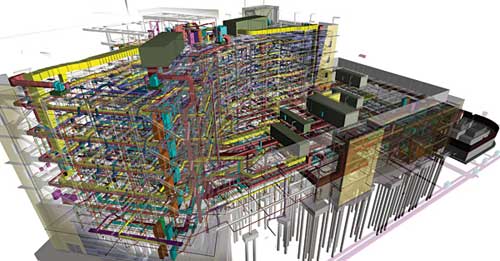 |
BIM Models are more than 3D computer models; they are an integrated information resource. (Source: McGraw-Hill Construction 2009 Smart Market Report - The Business Value of BIM) Photo courtesy of GHAFARI Associates |
The integration of both graphic and non-graphic information in one place gives the Model much more value as a resource that can be accessed by many people instead of wasting time and money to duplicate. The current wastefulness and redundancy in building design and construction work, while difficult to accurately quantify, is estimated by NIBS at a figure approaching $400 billion dollars annually, without taking operating processes into account. Eliminating this waste has been a key motivator on the part of owners and others who seek a superior building outcome by incorporating a more coordinated non-redundant methodology.
NIBS has also launched a specific initiative known as the buildingSMARTallianceâ„¢, which has compared the rise in the use of electronic modeling for buildings to similar changes that have preceded it in the aircraft, microprocessor and automotive industries. Based on those other industry successes, BIM is usually characterized as having several key features:
• Digital or electronic format. The Model is created entirely on computers.
• Parametric object-based. The information in the Model is not a series of lines and shapes as in many Computer Aided Design (CAD) applications, rather it is a collection of three-dimensional "objects" that are inserted or virtually "built" into the Model. The objects are often selected or created generically in BIM software programs or custom created by design professionals. Parametric objects are those that automatically adjust to other objects in a model, such that if a change is made to the model that affects the size or location or spacing of the object, it moves and adjusts accordingly.
• Embedded information linkage. Beyond the physical representation of an object, the functional data (e.g. specifications, warranty, manufacturing information, etc.) associated with that object is embedded or linked to the BIM object and readily accessible and readable.
• Interoperable. With information coming from multiple sources, the ability to openly and easily share that information in generic formats without the restrictions of proprietary software becomes critical. This point is common among a number of computer-based activities and has strong precedent elsewhere. In fact, the Institute of Electrical and Electronics Engineers (I-triple E) has spent a considerable amount of effort looking at this topic and offers this definition of interoperability: "The ability of two or more systems or components to exchange information and to use the information that has been exchanged."
A Model that incorporates all of these features lives up to the true definition of BIM and its ability to deliver desired results.
THE GROWING USE OF BIM
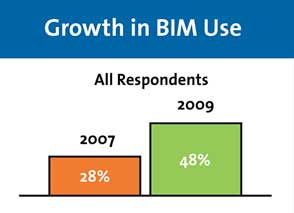 |
|
Source: McGraw Hill Construction 2009 Smart Market Report - The Business Value of BIM |
Of course, any tool is only of value if it is actually used and put into practice. In order to understand the current and projected usage trends and perceived value of BIM in practice, McGraw- Hill Construction has undertaken a series of objective studies in partnership with NIBS, the American Institute of Architects (AIA), and others and published the findings as a "Smart Market Report - The Business Value of BIM" (see  www.aia.org/ipd). The 2009 printing of this report updates the findings of the prior 2007 edition and reveals some insights into who is using BIM and why. This study is based on input from information gathering surveys from literally thousands of participants that came from all parts of the Architecture, Engineering and Construction (AEC) spectrum across North America. Some of the highlights of this study are summarized below:
• Almost half (49%) of the total AEC industry is now using BIM. This usage level is up considerably since 2007 when the same study revealed that only 28% of the total industry was using BIM or BIM related tools at that time. This represents some dramatic recent growth - a 75% increase in two years. Further, proficiency is up dramatically too with three times as many users characterizing themselves as advanced or experts - 42% in 2009 compared to only 14% in 2007.
 |
Source: McGraw Hill Construction 2009 Smart Market Report - The Business Value of BIM |
In light of these findings, Steve Jones, one of the co-authors of this report from McGraw-Hill Construction has said, "With about half the North American AEC industry already up off their beach chairs and at least wading ankle-deep in the BIM surf, we can stop hyperventilating about "BIM" and just do BIM as a regular course of business."
• All BIM users plan significant increases in utilizing BIM. Fully one third of all current BIM users surveyed report employing BIM on 60% or more of their projects today, but twice as many users expect to be at that level in the next two years. Of those not yet using BIM, half have yet to try it, although they are open to it, and at least 42% of non-users believe that BIM will be either highly or very highly important in the next five years. The trend of increased usage observed during the past two years appears that it will continue based on these survey results.
• Different groups of users have differing usage levels, but the majority of users overall are seeing real business benefits directly attributable to BIM. The report breaks down some interesting observations about the different groups using BIM:
 |
Source: McGraw Hill Construction 2009 Smart Market Report - The Business Value of BIM |
Â
- Architects:BIM used in the AEC industry is credited to have gotten its start within the architectural community and this early adoption has architects still reigning as the highest users of BIM. As many as 60% of architects report creating some form of BIM Model in their practice and two thirds of those report that they find high value in the core design development and construction document phases of a project. This value is based on higher productivity and a reduction in the need to re-work designs.
- Engineers: Overall, this group of design professionals lags behind architects with only 42% of engineers reporting using BIM, which is actually lower than the usage percentage of contractors. Among the common resistance expressed by engineers is the availability of sufficient engineering content that is BIM compatible or a perception that this approach doesn't apply to their particular practice of engineering. On the positive side, engineers see the reduction of conflicts and changes during construction as the top ways that BIM adds value to a project.
- Contractors:This group is growing faster in usage than any other with 50% currently reporting using BIM or related tools compared to only 13% in 2007 - a fourfold increase in only two years. This growth is likely fueled by the finding that nearly 70% of contractors that are using BIM are finding high value with greater chances of avoiding errors and omission problems during construction, enhancing productivity, avoiding conflicts, and improving performance on both budget and time schedule.
- Owners: As a group, approximately 37% of building and facility owners report using BIM, even though many have yet to realize the long term operations and maintenance benefits. Nonetheless, 70% of those utilizing BIM for design and construction projects see positive value through such benefits as lower overall project costs, clash detection, avoiding rework, and a generally overall better construction outcome.
- Material Fabricators:Accurate information and dimensioning are the keys to successful material fabrication in any construction project. By bringing fabricators into the design and construction process earlier rather than later, they can collaborate with the rest of the team to provide input and extract data from the BIM Model rather than recreate it separately. In this way the project can benefit from improved overall quality, easier constructability, the reduction of waste, better timeliness in fabrication schedules and a resulting improvement in affordability.
- Building Product Manufacturers: This group is just beginning to realize the potential benefits of incorporating BIM into the way that they communicate and interact with all of the other players above. Some are developing their own libraries of their products as complete BIM objects. Commercial services are also working with a steadily growing number of manufacturers to make BIM objects of their products available to those creating and using BIM models.
Overall, then, the report points out that "the ability of teams to create richer models and share more data with BIM has helped foster more collaborative decision making on projects. BIM has proven an effective tool for this [integrated project] delivery method, breaking from the tradition of handing off completed work from one team member to the next with little or no input from others." It also summarizes the resulting overall benefits related to saving time and money through 1) conflict avoidance/resolution, 2) increased productivity/ efficiency and 3) the avoidance of rework/ changes. Beyond saving time and money, however, there are other overall benefits for all parties including 1) a better understanding of the project throughout the phases or stages, 2) better collaboration, and 3) better visualization. Some future trends also noted include the potential to reduce the need for submittals and shop drawings while allowing more time for design and less time for documenting/ processing.
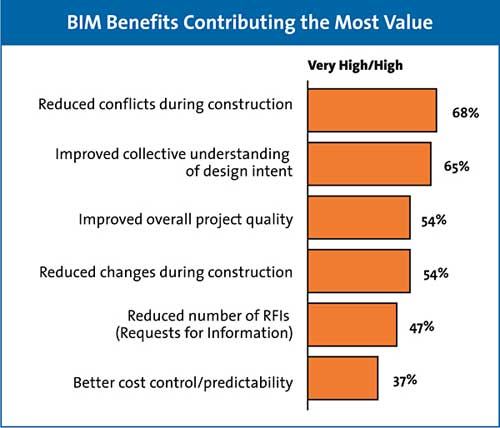 |
Source: McGraw Hill Construction 2009 Smart Market Report - The Business Value of BIM |
THE ROLE OF MANUFACTURED, COMPLEMENTARY BUILDING PRODUCTS IN BIM MODELING
As previously noted, building product manufacturers are beginning to become increasingly involved in providing their product information as fully developed BIM objects. This is coming about for a variety of reasons including:
• Recognizing change.Manufacturers are beginning to see that BIM is quickly replacing CAD as the preferred design tool by the architectural, engineering, and construction community.
• Filling a need. The creation of libraries of specific objects is time consuming and often not cost effective for design firms, particularly for objects of multiple manufacturers. Having readymade objects that are accurate, up to date, and customizable to suit a particular project helps architects realize the full potential of BIM through greater efficiencies of time and integration of data.
• Staying current. Products change and so does BIM software. Manufacturers who are in for the long term recognize the reality of needing to keep their information and data updated with new product offerings and changes as well as maintaining full compatibility with changing software programs. Adopting and maintaining a BIM approach to conveying their product information provides manufacturers with the best way to integrate with the AEC community.
Understandably, some project owners do not allow the pre-selection of a single manufacturer, favoring instead the open bidding approach of providing the design criteria in drawings and specifications for multiple manufacturers to demonstrate compliance with. In other cases, owners have prior experience or even standing accounts for particular products and manufacturers and want to ensure that those products get used again. In either case, a discussion with the owner at the outset of a project is important to ascertain what the basis of design will be in the project regarding manufactured building products. With more product information becoming readily available in BIM format and more collaboration of designers, constructors, suppliers, and manufacturers earlier in the design and construction process, the trend is clearly heading toward making specific product selections sooner rather than later. Hence, selecting and using specific products in the overall building model would appear to be consistent with that trend.
Certain building products fit into the category of "complementary building products." The term comes from the definition of "acting as or providing a complement (something that completes the whole)." They are products or parts of buildings that are typically installed late in the stage of construction that complement or complete a portion of a building to get it to its finished functional state.
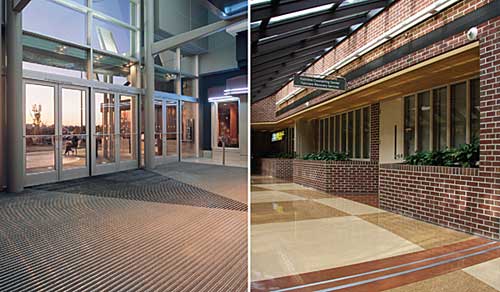 |
Complementary building products include integrated parts of buildings such as entrance flooring and expansion joint covers. Photos courtesy of Nystrom, Inc. |
Â
These products may also be referred to as specialty or miscellaneous products, but it is likely that they are part of virtually every building being undertaken today. They include code and safety related things like roof hatches, smoke vents, access panels, and fire extinguishing equipment plus products needed to meet engineering requirements, such as air louvers and expansion joints. It can also include interior items such as floor entrance mat systems, stair nosings, and wall protection products. In the grand scheme of a building, they can often go relatively un-noticed, which may actually be the overall design intent. However, they can become a strong focus of concern when it is time to demonstrate code compliance or achieve final project close-out at the end of construction. More significantly, they are often items that building operating and maintenance personnel will use and need to find information about on a regular basis.
Architects typically incorporate and specify most of these complementary building products, so there is a need for awareness about the nature of these products and the ways that they can fit into and contribute to a BIM Model as well as the finished building:
• Design Integration. Complementary building products are typically integrated as part of an overall building system; therefore architects need to think about how the product they are selecting will relate to its context. It usually becomes quite apparent in a finished building when these products were properly selected and integrated into an overall design and when they were only an unfortunate afterthought. For example, expansion joints typically require multiple choices to be made to integrate them into the interior floor, wall, and ceiling or exterior wall and roof. Using the BIM Model to take into account how the expansion joint meets with and integrates into the floor, roof, and wall systems will reveal whether or not the selected products truly work with each other and the surrounding building materials. This level of visualization and conflict avoidance will help architects to better understand the products and their purpose while contributing to the preferred appearance, functionality, maintenance, and overall operation of the building.
• User needs. Some products have uses that need to be considered other than just meeting a code or engineering requirement. For example, smoke vents are required to vent out smoke in case of a building fire and may need to be sized and located to meet a particular code, but the desired use and operating requirements may well go beyond that. By working with the owner, user, or maintenance personnel the architect can discover how and when the smoke vent may need to open not just for an unintended fire, but also for some other intentional activity such as a theatrical performance that needs to vent out fumes from a pyrotechnics show. Incorporating a smoke vent as a fully configured BIM object into a model can reveal for designers and operators the options of how the doors close again once they are opened, how to integrate them with building security needs, and how the smoke vent ties into the roof structure and roofing membrane.
• Timing of selection. Selecting specific BIM object information during design, rather than construction, will engage the architect deeper in the final selection process rather than leaving the choice solely up to the contractors. It may also eliminate the need for submittals and shop drawings if that information is essentially embedded in the Model and is in fact built accordingly. By selecting an exact product earlier, and giving contractors and subcontractors more focused rather than generic specification, this selection will allow for time savings and potentially better pricing when bids are being assembled. Assuming that competitive bidding is still employed, this approach allows for the Owner to get the best price for their project by allowing contractors to bid "apples-to-apples" and reduce the amount of duplication and/or unknown requirements that can cause inflated pricing.
• Customization. Complementary building products typically are able to be configured and customized rather than be restrained to "off the shelf" solutions. Some manufacturers will emphasize their abilities in this regard by pointing out that their manufacturing processes allow for flexibility in product design and other characteristics such as finish and color, usually without impacting scheduled lead times or affordability. Using BIM, manufacturers can present customizable objects that are easy to select and configure so that the right product can be chosen to provide the desired aesthetics, correctly work with the adjacent construction, and truly meet the Owners expectations of functionality. Architects, then, no longer have to be restrained to design around a limited venue of complementary building products rather they can select, configure, and customize these products to best fit the overall building design.
 |
The ability of complementary building products, such as wall louvers, to be customized into a building allow them to enhance any design style. Photos courtesy of Nystrom, Inc. |
Â
• Complete information.Architects shouldn't be expected to know everything off the top of their head about all the products they incorporate into their designs, rather, they need to know where to get the right information when it is needed. The use of fully embedded BIM objects greatly reduces the amount of time needed to find and use that information. Having complete specification information including code compliance and testing information readily available allows the designer to select products that meet all of the building design requirements while avoiding the potential for construction change orders or time delays if a product use is questioned.
Overall, then, using BIM objects from complementary building product manufacturers has the potential to contribute to more complete and accurate building designs that put the right product in the right place at the right time. At least one manufacturer takes pride in being able to schedule the product to be delivered right to the site when it is needed for installation.
PRACTICAL CONSIDERATIONS OF BIM
Risk management
BIM has been addressed by risk management and insurance firms in a variety of ways. One of these firms, Victor O. Schinnerer & Company, Inc., has observed, "BIM is not just the electronic transfer of paper documents. It greatly increases the ability to control and manipulate data and information in an unprecedented way and in an interoperable format. The move from paper-centric information to parametric, model-based information means that the digital design can be used for cost estimations, simulations, scheduling, energy analysis, structural design, GIS integration, fabrication, erection, and facilities management." In essence, they concur that this is a broader way of thinking and a much more collaborative way of creating a central base of information about a building. Nonetheless, there is a need for leadership and control of that information in order to manage and control risks associated with responsible control of the data and its use. Schinnerer has addressed this point by stating, "Professional service firms should be in control of the information source. As integration of design and construction develops, protecting public health, safety, and welfare becomes more critical. The rationale for having a licensed professional in charge makes increasing sense." Hence the role of the licensed architect or, in some cases, a licensed engineer as a leader and the entity in charge of the BIM Model is a significant part of the properly managed collaboration. It also means that all those who want to contribute to a BIM model should seek out the architect first for the appropriate review and eventual inclusion of their information into the Model.
Characteristics to look for in BIM objects provided by Building Product Manufacturers
Building product manufacturers, especially those who produce complementary building products, have been aware of the importance of the role of the design leader and usually seek to provide usable information accordingly. When architects and engineers are selecting BIM objects prepared by building product manufacturers to incorporate into an overall Model, they should look for the following characteristics in those objects:
• Up to date information readily available. Access to information when it is needed is critical to keeping a project on schedule. But that information has to be current and up to date, otherwise a lot of time is wasted detailing the wrong things. Historically, the architect has relied on manufacturer's representatives to update the office library with catalogs, CDs and other information for handy reference. The shortfall in this process is the possibility that the catalogs become out of date without a designer realizing it. Recognizing this, many product manufacturers offer their entire product and design information electronically on their company website. Others are working through independent company sources (such as Sweets, Reed, ARCAT, etc.) that provide manufacturer information in catalog and electronic format and are becoming sources of a growing library of BIM objects. Obviously, working with a manufacturer that can provide up to date, readily available BIM objects for inclusion in an overall BIM Model will be easier than creating a generic object in the design studio.
• Accurate visual representation.The BIM model needs to predict the built condition as closely and as accurately as possible. Hence the same is true with building products that are inserted as objects into that model. It is important that the visual characteristics of the computerized object match the detail and properties of the actual physical object. This is easily revealed by comparing the computerized object to photos or samples of the physical object and looking for similarities and discrepancies in details and features.
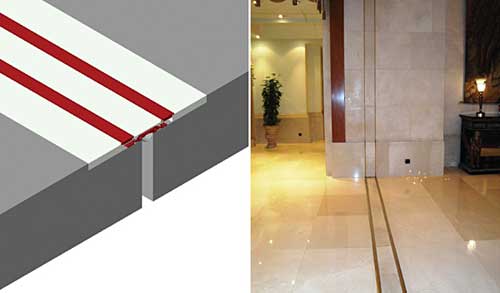 |
A BIM model showing an expansion joint with integrated cover and the installed condition. Photos courtesy of Nystrom, Inc. |
Â
• Complete embedded information. This is where the value of BIM for products really shines. All of the relevant information associated with a selected product should be readily accessed and readable from the BIM object. That means that manufacturers make and model numbers, full product specifications, cost/pricing information, production and delivery requirements should all be readily available. For the long term benefit of the owner, it should also include a link to the warranty, maintenance, and replacement information related to the product.
• Parametric modeling capability. Most BIM software programs allow for automated interaction between different objects. This interaction is governed by a set of computer programming rules that an object must follow anytime a modification or insertion of an object is made. This process is referred to as parametric modeling and is one of the key advantages of using BIM. It means that an object not only provides data about itself, it also has the ability to interact with the rest of the model, such that a change in the object triggers a corresponding change to other parts of the model. For example, inserting a louver into a wall means that the wall has to change to accommodate it. If the louver is one of several and a schedule or chart is part of the Model summarizing the details of all of the louvers, then the schedule has to be updated. And if a particular louver has several options built into it, the selection of those options should automatically be reflected in all aspects of the Model. In simple terms, parametric modeling is the means to make this all happen.
• Complete and open interoperability. Anyone who has ever tried to open a computer file that produced either an error message related to non-compatibility or a display of unintelligible characters will readily understand the need for seamless integration of information from multiple sources. That is what is meant by interoperability - the ability to access complete and accurate information regardless of the source of the different parts of the information. The data from building manufacturers, then, needs to be provided in a format that is accessible by all software identified as important on the project.
Resources available supporting the growth and adoption of BIM
A number of organizations and coalitions are working to support the already growing adoption and use of BIM. These efforts serve as significant resources and opportunities for anyone that is developing BIM Models or objects in their own work.
• The American Institute of Architects (AIA). The AIA has an ongoing strategic initiative related to Integrated Practice/ Integrated Project Delivery (IP/IPD). This approach "leverages early contributions of knowledge and expertise through the utilization of new technologies, allowing all team members to better realize their highest potentials while expanding the value they provide throughout the project life cycle. Through an integrated project delivery method, owners, designers, and builders can move toward unified models and improved design, construction, and operations processes".  www.aia.org/ipd In addition, the AIA Technology in Architectural Practice (TAP) Knowledge Community serves as "a resource for AIA members, the profession, and the public in the deployment of computer technology in the practice of architecture. TAP members monitor the development of computer technology and its impact on architecture practice and the entire building life cycle, including design, construction, facility management, and retirement or reuse." The AIA also sponsors multiple events during the year such as conferences or seminars that focus on BIM and related topics. Further, annual design awards are given specifically for BIM generated projects.  www.aia.org/tap
• National BIM Standards. Recognizing that the overall industry is still rather fragmented and current efforts are often built within the purview of individual initiatives, NIBS has created the buildingSMARTalliance ™, which is developing a National BIM Standard (NBIMS), similar to National CAD Standards that have been in use for some time. Through this effort, the goal is to establish needed uniform standards that can be used by all parties to "foster innovation in processes and infrastructure" and "weave information needed to create and operate wonderful buildings." The buildingSMARTalliance ™ is not only the home for this common standardization activity it is also tasked with industry-wide coordination, outreach, education and adoption activities. As Deke Smith, FAIA, Executive Director of the buildingSMARTalliance™ puts it, "We are working on creating the basic infrastructure so that open access to all is achieved." Hence, the development of NBIMS will help to elevate everyone to a more common working place based on interoperable, open standards and processes.  http://www.buildingsmartalliance. org/index.php/nbims/
• The Construction Operations Building Information Exchange (COBIE). The Whole Building Design Guide (http://www.wbdg. org/resources/cobie.php) is another initiative of NIBS. It recognizes that operations, management and maintenance of buildings require the transfer of information at the end of construction or renovation projects. Most contracts require the handover of paper documents containing such information in the form of equipment lists, product data sheets, warranties, spare part lists, preventive maintenance schedules, etc. COBIE has been developed as a standardized process to address and update this need. By incorporating this process, designers provide space layout, submittal register, and equipment list in one file that others can use. Since it is based on being an exchange format, it does not require specific software. Hence, it can be provided manually or through the use of CAD or BIM files. Since one of the benefits of BIM is to house all of this information in one usable, interactive place, the connection between COBIE and the growth of BIM becomes readily apparent.
• General Services Administration. "In 2003 the General Services Administration (GSA), through its Public Buildings Service (PBS) Office of Chief Architect (OCA), established the National 3D-4D-BIM Program. OCA has led over 30 projects in its capital program, and is assessing and supporting three dimensional (3D), four-dimensional (4D), and Building Information Modeling (BIM) applications in over 35 ongoing projects across the nation. The power of visualization, coordination, simulation, and optimization from 3D, 4D, and BIM computer technologies allow GSA to more effectively meet customer, design, construction, and program requirements. GSA is committed to a strategic and incremental adoption of 3D, 4D, and BIM technologies." (Source: http:// www.gsa.gov/Portal/gsa/ep/contentView.do?contentType=GSA_OVERVIEW&contentId=20917)
CASE STUDY EXAMPLE
The Building Information Model Awards, given by AIA Technology in Architectural Practice (TAP) Knowledge Community, honor projects that highlight proven strategies and the latest trends in design and technology in the building industry. The 2009 "Juror's Choice" Award is presented here as a case study of an exemplary building that used BIM to achieve the project goals and illustrate the connection between the BIM model and the building as constructed. The jury comments included, "An amazing tour de force...it will change New York architecture. It will wake people up," and "...a complete demonstration of BIM's integration ...broad, rich engagement of team members ...a clear winner." Excerpts from the submission are presented below with the full presentation available at  http:// www.aia.org/aiaucmp/groups/aia/documents/pdf/aiab081564.pdf
 |
BIM Model and the Cooper Union building under construction. (Source: AIA 2009 BIM Awards and Morphosis Architects) |
Â
"The Cooper Union New Academic Building is conceived as a stacked vertical piazza, contained within a semitransparent envelope that articulates the classroom and laboratory spaces. The vertical campus is organized around a central atrium that rises to the full height of the building. The interior space configuration encourages interconnection among the engineering, art, and architecture departments. The skip-stop elevator system makes trips exclusively to the fourth- and seventh-story sky lobbies that surround the atrium, drawing occupants to congregate on the grand stair. These key social spaces become the places where education informally takes place. The building's physical and visual permeability helps integrate the college into its neighborhood. A steel-and-glass skin improves the building's performance through control of daylight, energy use, and selective natural ventilation. The facility is exemplary as sustainable, energy-efficient architecture, slated to receive a Platinum LEED Rating - superior to any other lab building in New York."
"Using BIM helped the design team to be the know-how in the building process, re-establishing the original meaning of the word architect - that of master-builder on a highly collaborative project delivered with traditional contracting relationships. The model was used not just to facilitate prefabrication, but to economize even the most hand-made elements of the project.
During the design phases, using techniques evolved over many years, the model served many purposes: massing to illustrate the zoning envelope and building program; solar studies; visualization; production of construction drawings; 3DPrinting and laser cutting scale models for communication with clients, engineers, and contractors; and production of wind tunnel models.
The key to the models' success in all of these purposes was the ability to both provide a holistic view and also break down the project into subsystems that are by-themselves complete and easy to understand, greatly improving comprehension of the design, and greatly reducing the uncertainty that leads to higher costs. Each subsystem represents a complete description of work by itself, but anticipates connections to adjoining subsystems. Through the process of digitally-integrated design build, at project completion, these subsystems synthesize a broader whole to become the architectural work."
 |
BIM Model object detail and the Cooper Union detail construction. (Source: AIA 2009 BIM Awards and Morphosis Architects) |
Â
"A key component of the project's high energy performance goals was the use of Radiant cooling and heating ceiling panels. A building assembly's layers are often separated between trades, with trade unions formalizing the boundaries. In order to construct a ceiling system which integrated several trades and performed many functions, the design team devised a system which formed a tightly integrated whole while dividing the installation into several trades including lighting, HVAC, and radiating ceiling tiles, hanging from a secondary structure suspended from the concrete structure. Through digital integration, the AECO team could select the most appropriate methods for a given layer of an assembly and rely upon assistance from the model to ensure that the parts would fit together. In this case, the design process resulted in architectural construction documents which included an exploded axonometric drawing showing the assembly broken out by trade: structure, secondary suspended structure, electrical/lighting, ceiling support channels, HVAC diffusers, ceiling tiles. This, in conjunction with coordination models of the ductwork and piping and a 3D model of the structure, made it possible to anticipate any issues that might arise in fabricating and installing the ceilings and HVAC."
"It is important to note at this point that the project's budget is roughly 70% the cost of comparable projects in New York City. By combining BIM expertise and integrated practice, it is possible to make the most effective use of the construction trades available, greatly expanding the realm of what's feasible for a given budget. The owner, contractor and AE team are all enjoying a positive experience on the project."
|

